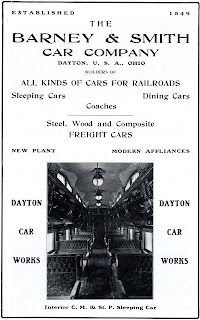 So what was the Barney and Smith Car Company? It was a railroad car builder. Chapel Car Messenger of Peace (and indeed many of the passenger cars in the Northwest Railway Museum Collection) was manufactured by Barney and Smith.
So what was the Barney and Smith Car Company? It was a railroad car builder. Chapel Car Messenger of Peace (and indeed many of the passenger cars in the Northwest Railway Museum Collection) was manufactured by Barney and Smith.
Barney and Smith was the premier car builder of the 19th Century and was located in Dayton, Ohio. Its car building efforts began in 1849 as the E. Thresher and Company and the initial organization included $10,000 of capitalization with partners Eliam Barney and Ebenezer Thresher. They gradually expanding production, weathered several recessions, added several more partners and by 1867 had expanded their capitalization to over $500,000. In 1867, this was a truly vast sum and is indicative of the prominence of railroads in the 19th Century.
During the Civil War E. Thresher and Co. expanded production to fill orders from the United States Military Railroads and in that era added many modern manufacturing facilities including their own steam kiln to dry lumber, a facility to manufacture coke, and an iron foundry. Then as now, war time production work was very lucrative.
By 1864, Mr. Preserved Smith joined as a partner and the company was henceforth known as the Barney, Smith and Company. In 1867, the Barney family gained control of the enterprise when Eliam Barney and his son Eugene bought out two earlier investors. Reorganized as the Barney and Smith Manufacturing Company, the officers were all family relatives except for Preserved Smith.
Illustrating the importance of B & S in that era were orders from Pullman. Beginning in 1859 George Pullman ordered sleeping cars from Barney and Smith and continued as a customer until 1881, when their own manufacturing facilities were able to meet all their requirements. Similarly, Pullman’s competitor, the Wagner Palace Car Company, also purchased many of their sleeping cars from Barney and Smith.
In 1892 Barney and Smith became a publically traded corporation. An initial stock offering of $4.5 million was purchased in part by a group of Cincinnati, Ohio investors. The company was reincorporated in West Virginia – though operations remained in Dayton – and the name was changed to the Barney and Smith Car Company. Certainly for the Barney family, this was a wise move because by 1893 the world economy was beginning to feel the effects of a major recession.
Barney and Smith manufactured both freight and passenger cars. By 1896 and the end of the global recession, it was clear that steel was the emerging technology for all car construction but unfortunately Barney and Smith was slow to adapt. For example, by 1906 Pullman had converted most of their manufacturing to steel while Barney and Smith was just beginning to make the shift. This resulted in substantial orders for competitors who had switched from wood to steel.
The failure to adapt to steel construction was arguably the greatest factor that led to the deminse of Barney and Smith. Other issues included general management blunders, the rise of competitors such as American Car and Foundry and Pullman, a car shop fire in 1905, and a devastating Ohio River flood in 1913 that effectively shut down remaining production in a fashion that never fully recovered. Nothing the company could do compensated for what was a gradual but ultimately substantial loss of market share.
The company was in serious jeopardy by 1913 but managed to remain in business – albeit with few orders to manufacture – until 1921. The remaining assets of Barney and Smith were auctioned off in 1924.


The 1913 flood that put Barney & Smith out of business was the Miami River, and several others that flooded. The Barney & Smith manufacturing company was not even close to the Ohio River.